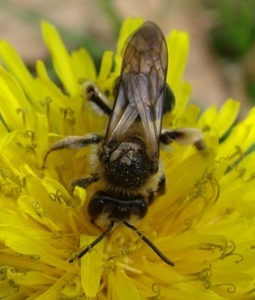Each year as the weather warms up and we get closer to spring, the number of TV commercials for herbicides increases as well as the number of posts I see on social media about homemade herbicides. The homemade herbicides are often touted as being safe because they are made from things you can find in your kitchen. However, just because it is in your kitchen doesn’t mean it is completely safe. After all, the purpose of these homemade herbicides recipes is to KILL something, even if it is “just a weed.”
So, what should someone do if they need to get rid of the weeds in their yard? Unfortunately, there isn’t a simple answer that works in all situations and for every person. Instead, we each have to make our own decisions about what we want or need to do in our own yards and that answer may change depending on the situation. With that in mind, before you spray anything, whether a commercial herbicide or a homemade one, here are a five things I encourage you to consider if attracting pollinators and other backyard wildlife to your yard is one of your goals.

1) Do you really need to get rid of the weed?
Many of the plants we consider “yard weeds” provide nectar and pollen for pollinators and other insects. These pollinators and other insects are often food for songbirds. So by leaving dandelions, clover, and other yard weeds you are not only directly feeding many different types of insects but are also indirectly feeding larger animals like songbirds. Clover is also good for your soil because of its role in nitrogen fixation. Not to mention, the pops of color that dandelions, clover, and other yard weeds add to a yard can be pretty, and not doing anything about them gives you more time to do other fun things.
2) Can you dig or pull the weed?
Ok, maybe leaving the weed or weeds isn’t an option. Digging or pulling the weed is often the most environmentally friendly way to get rid of it, especially if there are only a few weeds in a small area. Just be sure to get the root so that it doesn’t grow back.
3) How does the herbicide you are considering work?
Alright, so leaving the weed or weeds isn’t an option and neither is pulling or digging the weeds. You’ve decided that you need to use an herbicide. In deciding exactly which herbicide to use, whether one of the commercial ones or a homemade one, it is important to understand how it works. Most of the homemade herbicides kill the vegetative portions of the plant (leaves and such), but don’t touch the root. In other words, the weed will grow back. Many homemade herbicides will also require multiple applications to kill any part of the weed.
Many commercial herbicides are designed to kill the root, so the weed is less likely to come back or need multiple applications. Commercial herbicides have also been tested and come with instructions regarding how much to use and when the best times are to apply the herbicide. There are even some commercial herbicides that will just kill grasses or other monocots if that is what you are trying to get rid of.
4) What unintentional consequences might the herbicide have?
Whether you are using a commercial herbicide or a homemade one, there are likely to be unintentional consequences of using an herbicide. Before commercial herbicides can be brought to the market, they must be tested. Research has shown that some of them can get in the water system, build up in the soils, drift to other locations, or cause harm to pollinators that come in contact with it. That is why it is so important to read and follow the directions for any commercial herbicide that you use. Properly applying the herbicide by following the directions will minimize the risks and unintentional consequences of the herbicide’s use.

Homemade herbicides aren’t tested, and therefore the risks and unintentional consequences of their use are less understood. However, that doesn’t mean they don’t have risks or unintentional consequences. Vinegar and/or salt are two common household ingredients used in many homemade herbicide recipes. They are often assumed to be “perfectly safe” because they are such common food ingredients, but consuming too much vinegar or salt can kill a person, which means they aren’t “perfectly safe.” A few years ago, the Ohio State University Extension Office wrote an interesting article related to this topic titled “Vinegar: Is it a Safer Herbicide?” that compares the human toxicity of vinegar and Roundup.
The OSU article just discussed human toxicity of vinegar, but what about other unintentional consequences or risks of homemade herbicides? Vinegar is an acid. Depending on the concentration at which it is applied, it can burn or even kill amphibians and small invertebrates that it comes in contact with. If applied too often or at too high of a concentration to the soil, it can even temporarily change your soil’s pH. How long that temporary change in your soil’s pH lasts depends on several factors including the concentration and amount of vinegar that was applied.
Salt is a desiccant and can have detrimental effects on amphibians and small invertebrates that come in contact with it by dehydrating the organisms. High concentrations of salt can also change the salinity of your soils, which can affect what plants, if any, can grow in there in the future. Changes in soil salinity due to the addition of salt often last much longer than changes in soil pH due to the addition of vinegar. Other ingredients in different homemade herbicide recipes can have other impacts. In my opinion, the last paragraph of the OSU article really is true and so important to understand. No matter what you use, if you are using it to kill something, then it is a toxin and needs to be properly applied.
5) After the weed is gone, how do you keep it that way?
If the weeds you needed to get rid of were just a few dandelions in the yard, then there isn’t much you can do to keep other dandelions from coming back. However, if the area that you were trying to clear of weeds was in a garden bed, around the house, or maybe along a fence row, then you might want to consider ways to keep the weeds from coming back. This could mean applying a thick mulch to the area to suppress the weeds. Adding landscape fabric or cardboard under the mulch can suppress the weeds even more. Suppressing the weeds after they are gone can save you time and money in the long run by making sure you don’t have to continually repeat the process that you just went through to get rid of them the first time.

This article was part of Shannon’s original Kentucky Pollinators and Backyard Wildlife blog which evolved into the blog for Backyard Ecology.

Backyard Ecology: Exploring Nature in Your Backyard
Nature isn’t just “out there.” It’s all around us, including right outside our doors. Hi, my name is Shannon Trimboli, and I am the host of Backyard Ecology. I live in southcentral Kentucky and am a wildlife biologist, educator, author, beekeeper, and owner of a nursery specializing in plants for pollinators and wildlife conservation. I invite you to join me as we ignite our curiosity and natural wonder, explore our yards and communities, and improve our local pollinator and wildlife habitat. Learn more or subscribe to my email list at www.backyardecology.net.

Leave a Reply